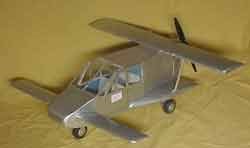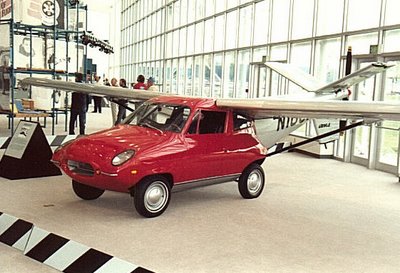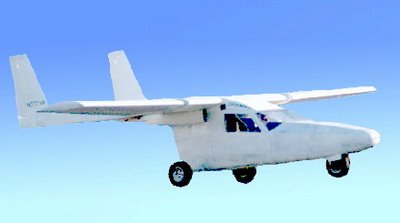MIT graduate student Carl Dietrich has a simple dream. He wants to be able to fly his own plane to any airport in the U.S. Then, once he has landed, taxied off the runway, and made a few modifications, he wants to drive out of the airport and onto local streets -- using the same vehicle he flew in on.
Dietrich is no wide-eyed dreamer. The 29-year-old PhD. student is working on a prototype of what he calls "The Transition" -- because it will "transition" from the air to the road. The early sketches look like an SUV with fold-up wings. If all goes well, Dietrich's "roadable aircraft" could be on the market in the next few years.
So far, he's off to a good start. Dietrich's design won MIT's $30,000 Lemelson-MIT Student Prize for Inventiveness. He and his six-person team are currently drawing up plans to build a working prototype of a model they've tested in a wind tunnel.
HOVER CRAFT.For nearly 90 years, entrepreneurs, industrialists, corporations, and backyard tinkerers, have been captivated by the idea of a flying car. Maybe it's the image of Aladdin effortlessly zipping around on his flying carpet or George Jetson's breezy commute. "We all sit in traffic and we all think, 'Wouldn't it be wonderful if I could push a button and wings could sprout out and I could fly away home?'" says Lionel Salisbury, a former pilot and retired businessman who runs Roadable Times, a Web site that chronicles flying car designs and prototypes from 1917 until the present.
Right now, creating a flying car that can be mass produced is still a dream -- one that some believe is still decades away from being fulfilled. But Dietrich isn't alone in his efforts. Thanks to new high-tech composite materials that enable stronger and lighter designs, several small companies continue to pursue the dream of designing a flying car that can take off like a plane, or even hover like a helicopter.
What has scuttled efforts so far is the difficulty of rolling two technologies into one vehicle. "You pay too many penalties in one area to fit into the other," says Dorothy Cochrane, curator for general aviation at the Smithsonian Air & Space Museum, which houses several early flying-car prototypes. That presents the challenge of incorporating two very different control systems in one vehicle -- rudders and ailerons for the plane, gas and brakes for the car.
NATURAL PROGRESSION. Then there's the weight problem. The vehicle has to be light enough to get off the ground, yet heavy enough so that a strong wind doesn't blow it into oncoming traffic. Historically, Cochrane says, flying car designs have been too light and unstable to get real traction on the ground, and too slow and clumsy in the sky. "Flying cars so far do neither job very well," she says. "Perhaps someday someone will actually build even a reasonable design [that can find a significant market], but I doubt it."
While aviators have tried to build flying cars as early as 1917, the first successful prototype wasn't until the 1930s. Back then, it seemed like the natural thing to do. Both automobiles and airplanes were relatively new inventions. With cars like the Model T paving the way for mass production, why shouldn't the common man get airplanes too?
In 1933, the U.S. Air Commerce Bureau challenged aircraft designers to build a low-cost airplane that would sell for under $700. The government's Flivver competition, named after the Ford (F) Flivver, an earlier attempt at a simple inexpensive airplane, included some entries that were also "roadable"-- the wings and tail could be detached or collapsed so that the driver could take it on the road, says Cochrane. None of the car-like models ever caught on, and with the U.S. in the middle of the Depression, few people had money to spend on a private aircraft.
FLYING JEEP. In 1950, Robert Fulton, a trained architect and aerial photographer for Pan American with next to no aircraft-design experience, decided to build a hybrid car and plane he could use to take on his frequent business trips all over the U.S. The result was the Fulton Airphibian, a single-propeller monoplane with a detachable cockpit that became the first roadable aircraft to be certified by the Civil Aviation Administration, according to the Smithsonian.
Even the government tried to develop a flying car. In 1957, Chrysler, along with other auto and aviation companies, responded to a request from the military for the design of a flying jeep.
Chrysler built the VZ-6 -- a 21.5 foot-long oval-shaped craft with no wings or rotors. Instead, the pilot sat on top between two downward-facing wooden propellers.
The idea was that the propellers would turn, lifting the craft up and then allow the pilot to fly forward by varying speed and angle of the two. In one of its first test flights, the VZ-6 did manage to hover -- but when the pilot attempted to move forward, the prototype crashed and was severely damaged [the pilot suffered a scraped elbow].
ROTARY CLUB. Fast forward to 2006, and companies continue to work on similar vehicles. It's just that the prototypes out there today look more like something from Star Wars than any vehicle on the road.
Take Urban Aeronautics' X-Hawk. Founded in 2002 by Rafi Yoeli, a former Boeing Aircraft (BA) engineer, the company's design combines two rear propellers with two encased rotors that give it lift in the same way a helicopter takes off with its large external rotor. The company plans to market its craft as a medical evacuation vehicle for use in densely populated, high-traffic urban areas. So far, the company has built a simpler design, the City Hawk, which can hover several feet in the air.
Other companies, including Davis [Calif.]-based Moller International, are working on similar prototypes using the encased rotors. Paul Moller, who has made continuous attempts to market a flying car since 1983, says he expects that this year he will make the first manned, untethered test flight of the M400 -- a craft that uses four rotors and will be able to carry four passengers.
PORTABLE WINGS. Another independent designer, Robin Haynes of Auburn, Calif., is seeking funding to build a prototype as well. His model will look something like an SUV, and use a roof-mounted jet engine to power the wheels on land and propel the vehicle in the air. Haynes estimates it will take between $4 million and $5 million to build a flying prototype.
Dietrich, meanwhile, is planning to take a page out of the Flivver book. His airplane uses a small four-cylinder engine, and is designed to convert from a lightweight plane into a car by having the wings fold up and sit next to the sides of the vehicle. The engine that drives the propeller will then switch to the wheel base to propel the car. He hopes that the fact the wings remain part of the car will be a more convenient solution than earlier designs like the Airphibian.
"This is going to be a practical design -- you'll take your wings with you" says Dietrich. "The idea is to give pilots as many options as possible." Dietrich stresses that he has modest goals. He's aiming for the amateur-pilot market looking for a practical, simple, and affordable plane -- not people in the market for a futuristic auto. "A flying car is a dream," he says. "I'm trying to build an airplane with an additional capability. That's possible to do."
KEEPING THE FAITH. How long that will take largely depends on how much funding he can secure, he says. Dietrich is planning to present his wind-tunnel model at the Experimental Aircraft Association's AirVenture show this July in Oshkosh, Wis., in order to drum up investor interest. "We know it will take many tens of man-years to develop [The Transition]," he admits.
That could mean Dietrich's team could accomplish their goal in the next few years, if fully funded. Or, if history is any guide, it could be one more attempt that never takes off.
NBC
 The flying car, developed by students and faculty at the Massachusetts Institute of Technology, is attracting hundreds of potential customers and investors — and it hasn't been built.
The flying car, developed by students and faculty at the Massachusetts Institute of Technology, is attracting hundreds of potential customers and investors — and it hasn't been built.















